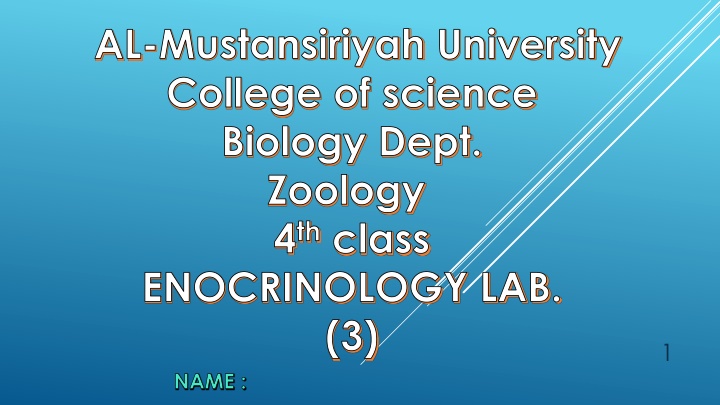
Posterior Pituitary Hormones and Related Disorders
Explore the physiology of posterior pituitary hormones such as oxytocin and vasopressin, their functions in the body, and disorders like hypopituitarism and gonadotropin disorders. Learn how these hormones affect processes like labor, milk ejection, and blood pressure regulation.
Download Presentation

Please find below an Image/Link to download the presentation.
The content on the website is provided AS IS for your information and personal use only. It may not be sold, licensed, or shared on other websites without obtaining consent from the author. If you encounter any issues during the download, it is possible that the publisher has removed the file from their server.
You are allowed to download the files provided on this website for personal or commercial use, subject to the condition that they are used lawfully. All files are the property of their respective owners.
The content on the website is provided AS IS for your information and personal use only. It may not be sold, licensed, or shared on other websites without obtaining consent from the author.
E N D
Presentation Transcript
AL-Mustansiriyah University College of science Biology Dept. Zoology 4thclass ENOCRINOLOGY LAB. (3) NAME : 1
Antidiuretic Hormone 2
Physiology of the Posterior Pituitary The posterior pituitary gland secretes two hormones which are: oxytocin , increase uterine contractions during parturition Contraction of mammary glands to secret milk and vasopressin or arginine vasopressin (AVP) (or Antidiuretic Hormone ADH ) contract vascular smooth muscle and thus raise blood pressure promote reabsorption of water by renal tubules Oxytocin and AVP are stored in and secreted by the posterior pituitary gland, but are synthesized by the hypothalamus 3 Dr. M. Alzaharna (2014)
4 Dr. M. Alzaharna (2014)
2. oxytocin 1. Contraction of smooth muscles of the uterus enhance labor. 2. Contraction of mammary gland myoepithelial cells of the alveoli & the ducts Ejection of milk as a reflex in lactating women. 3. In men ejaculation. Remember: Oxytocin is concerned with releasing or ejection of milk, while prolactin is concerned with synthesis & production of milk. 5 Dr. M. Alzaharna (2014)
Hypopituitarism Hypopituitarism is manifested by diminished or absent secretion of one or more pituitary hormones Hypopituitarism is either: a primary event caused by destruction of the anterior pituitary gland or a secondary phenomenon resulting from deficiency of hypothalamic stimulatory factors normally acting on the pituitary 6 Dr. M. Alzaharna (2014)
Gonadotropins Disorders Hyposecretion leads to amenorrhoea, sterility and loss of sexual potency. In the young, the sex organs and secondary sexual characteristics fail to develop (delayed puberty) Hypersecretion extremely rare, in children it could lead to sexual precocity (excessive premature development) 7 Dr. M. Alzaharna (2014)
Thyrotropin Disorders Hyposecretion produces a clinical picture similar to primary thyroid deficiency Hypersecretion gives the symptoms of hyperthyroidism similar to Graves disease (also known as toxic diffuse goiter), is an autoimmune disease that affects the thyroid. 8 Dr. M. Alzaharna (2014)
Corticotropin Disorders Hyposecretion rare causes failure of cortisol secretion, a general lack of health and well being, a reduced response to stress and skin depigmentation Hypersecretion due to a pituitary microadenoma, will result in Cushing s syndrome 9 Dr. M. Alzaharna (2014)
Prolactin Disorders Hyposecretion leads to failure of lactation in women Hypersecretion may result from a pituitary tumour principal symptoms are infertility and menstrual complaints in men, decreased libido, inadequate sperm production and impotence, whereas in women, there may be a complete lack of menstruation inappropriate (non-pregnant) milk production 10 Dr. M. Alzaharna (2014)
GHRH Disorders Hyposecretion caused by hypothalamic or pituitary dysfunction In childhood this leads to impairment of growth (dwarfism) Hypersecretion This usually results from a benign pituitary tumour In young patients, this leads to gigantism In adults, leads to acromegaly 11 Dr. M. Alzaharna (2014)
Vasopressin Disorders Hyposecretion caused by damage or dysfunction of the hypothalamus, can lead to diabetes insipidus, excessively large amounts of dilute urine (10 15 liters/day) are produced by the kidneys Hypersecretion rare condition of inappropriate AVP production is known as syndrome of inappropriate ADH (SIADH) 12 Dr. M. Alzaharna (2014)










